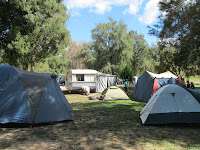My name is Harsh. I am 10 years old. I think Science, Maths, Reading and Spelling is exhilarating! My favourite sports are Cool Cricket and Spectacular Soccer. I love school.
My goals this year are:
- To get better at swimming
- To get a better position in the Street Race
- To improve in PE
CAMP
On the 5th of March 2013, it was the day..... no, not the boring old days when there's no maths, it was........ QUINNEY'S BUSH CAMP!!!!! I was incredibly over-excited!
The reasons we went on camp; we would get to know each other better, or you could overcome your fears and can learn and try out new and different activities.
My favourite activities were; Abseiling, Bivouacs, Damper making, Spotlight(too bad Miss Sefton couldn't play), Polar bear plunge, FREE TIME, FOOD and Go-Karts!
Mr T didn't do all the activities.
In the mornings it was colder than you can ever imagine but when the toast comes..... IT IS SOOOOOOOO SCRUMPTIOUS........... It makes you as warm as the spectacular sun.
Mr T didn't have to take us to camp but he did........ WHAT A NICE GUY! THANK YOU MR T!!!!!
 |
| CAMPBELL AND I ON BIG MAMA |
What a wonderful enthusiastic appreciative positive blog post. Keep up the amazing vocabulary. BW
MY CLOCK COOL
GALILEO GALILEI
Galileo Galilei was an Italian scientist who helped open the eyes of the world to a new way of thinking about the workings of our solar system and astronomy in general.
Galileo Galilei was born is Pisa, Italy, on the 15th of February 1564, he died on the 8th of January 1642.
Galileo was a ground breaking astronomer, physicist, mathematician, philosopher and inventor. Among his inventions were telescopes, a compass and thermometer.
Galileo enrolled to do a medical degree at the University of Pisa but never finished, instead choosing to study mathematics.
Galileo built on the work of others to create a telescope with around a 3x magnification, he later improved on this to make telescopes with around a 30x magnification.
With these telescopes, Galileo was able to observe the skies in ways previously not achieved. In 1610 he made observations of 4 objects surrounding Jupiter that behaved unlike stars, these turned out to be Jupiter's four largest satellite moons: Io, Callisto, Europa and Ganymede. They were later renamed the Galilean satellites in honor of Galileo himself.
VIDEO CLIP


















